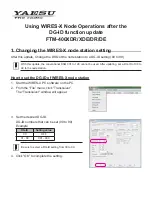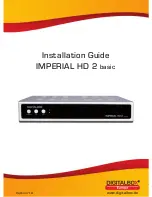
MOUNTING
OPERATION MODES
• The ROP-21 receiver is designed to be mounted in a junction box. Its dimensions enable both
flush (Ø60 minimum) and surface mounting. In case of a flush junction box, a deepened box is
recommended as it makes mounting easy with a large number of wiring and a big cross-section
of connection wires.
• The device is designed for a single-phase installation and must be installed in accordance with
standards valid in a particular country. The device should be connected according to the details
included in this manual instruction. Installation, connection and control should be carried out
by a qualified electrician staff, who act in accordance with the service manual and the device
functions. For safety reasons, do not mount the device without casing or with a damaged one,
as an electric shock may occur.
CAUTION! Before installation make sure the connection cables are not under voltage.
INSTALLATION:
1. Disconnect power supply by the phase fuse, the circuit-breaker or the switch-disconnector com-
bined to the proper circuit.
2. Check if there is no voltage on the connection cables by means of a special measuring equip-
ment.
3. Connect the device cables with the terminals in accordance with the installing diagram.
4. Install ROP-21 in a junction box.
5. Switch on the power supply from the mains.
MOUNTING REMARKS:
1. Do not mount receivers in a close proximity to each other (if there is a possibility, keep a distance
of minimum 15 cm between receivers). Particularly, avoid installation of one receiver over the
another.
2. The maximum output load must be obeyed:
• incandescent and halogen lamps: 750 W / channel
• fluorescent CFL lamps: 250 W / channel
• dimmable LEDs: 60 W / channel.
3. During mounting, make sure the receiver is not exposed to direct water and operation in an in-
creased humidity environment. The mounting ambient temperature range should be within the
range from -10 to + 55 °C.
4. The ROP-21 receiver is designed to be mounted indoor. In case the receiver is mounted outdoor,
it must be placed in an additional hermetic casing
5. Wired control switches can be connected to the IN1 and IN2 inputs of ROP-21 receiver. By de-
fault, the inputs are adapted to cooperate with monostable push-buttons in a bistable mode. It
means that each subsequent impulse given to the IN1 or IN2 input causes the output mode is
changed to an opposite mode.
6. After a receiver has been installed, it is important to check if it operates correctly. In case of
control by means of the EXTA LIFE system transmitters, they must be first programmed with a
receiver (see Programming transmitters). In case of cooperation with a controller, a correct pair-
ing of a receiver with a controller is required (see Register of receivers in the EXTA LIFE system).
7. After power supply has been applied, the receiver will carry out service activities for
about 5 seconds (it is signalled by a green STATUS LED, it will flash at an interval of 1
second). During this time the control of a receiver is not possible.
CAUTION: Input functionality (switch type, operation mode) can be changed by means of the
EXTA LIFE mobile application. It is necessary to install a controller in the system and pair it
with ROP-21 receiver – see Input functionality.
Switch on / switch off mode
• In the switch on / switch off mode two push-buttons of a transmitter are used. One push-button
always realises the “switch on” function and the second one the “switch off” function.
CAUTION! This mode is used to control a larger number of receivers by means of one
transmitter.
Bistable mode
• In the bistable mode only one push-button of a transmitter is used to control a receiver. The
same push-button realises the “switch on” and “switch off” function. Output control is realised
as a cyclical change of one mode by subsequent pressing the transmitter’s button. The bistable
mode allows for an independent control of a larger number of receivers by means of one trans-
mitter. For example, by means of 4 push-button remote control P-457/4, an independent control
of 4 circuits is possible.
CAUTION! It is not recommended that one push-button in a bistable mode is assigned to
more than one receiver. It can have output mode jitter effect during control.
Monostable mode
• In the monostable mode, only one push-button of a transmitter is used to control a receiver.
• A receiver’s output is switched on as long as the transmitter’s push-button is pressed.
Time mode
• In time mode only one push-button of a transmitter is used to control a receiver.
• A receiver’s output is switched on after a transmitter’s push-button is pressed, and it switches
off automatically after the adjusted time is over. Pressing a transmitter’s push-button during time
measurement causes the receiver’s output is switched off earlier (system without time retrigger).
Time switch on is programmed in the range from 1 sec. to 18 hrs. In case of ROP-21 receiver, it is
possible to adjust an independent time for each push-button programmed in time mode, for local
inputs and for control by means of an application.
Switch on mode
• This mode is available only by means of switches connected to IN1/IN2 inputs. In this mode, it
is only possible to switch on a receiver’s output.
Switch off mode
• This mode is available only by means of switches connected to IN1/IN2 inputs. In this mode, it
is only possible to switch off a receiver’s output.
Operation
mode
EXTA LIFE
transmitters
EXTA LIFE
application
Monostable
switch
Bistable
switch
Switch on/switch off mode
+
+ (default)
-
-
Bistable mode
+
-
+ (default)
+
Monostable mode
+
-
+
-
Time mode
+
+
+
+
Switch on mode
-
-
+
+
Switch off mode
-
-
+
+
In case of EXTA LIFE radio transmitters, the operation mode is carried out by adding transmitter’s
push-buttons to a receiver. In other cases, the operation mode is configured by means of the
EXTA LIFE application.



























